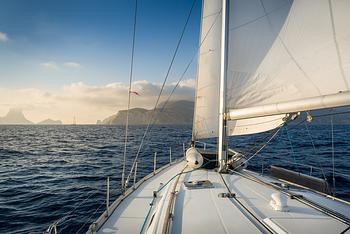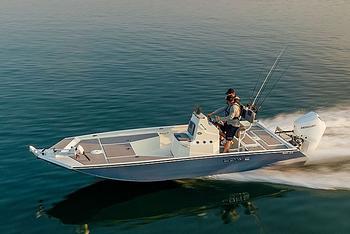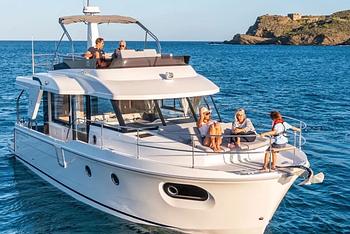Ketches and yawls are popular types of sailboats helmed by sailors around the world. Both are two-masted vessels with divided rigs, meaning the main sail area is divided between the two masts. The taller mast is the main mast while the shorter mast located behind it is called the mizzen mast. In the ketch vs. yawl debate, knowing these mast terms is key to understanding the differences between the two types of sailboats.
So, how can you tell the difference between a yawl and a ketch? Read on to learn everything you need to know about these types of sailboats.
What Is a Ketch?
The easiest way to tell a ketch and a yawl apart is by looking at the location of the mizzen mast. On a ketch, the mizzen mast is in front of the rudder post. The rudder post is where the front part of the rudder attaches to the underside of the boat. On boats steered with a tiller, the rudder post is typically located directly below the end of the tiller handle.
On ketch sailboats, the mizzen mast is shorter than the main mast. These sailboats can have triangular or square rigs, based on the specific design and age of the boat. With the sail area of a ketch split into two parts, the masts can be shorter than that of a single mast ship, so the load on each mast is less. Ketches often have Bermuda sails on both masts, although some modern ketches have gaff sails or both a gaff sail and a Bermuda sail. A ketch that has two or more jibs is called a cutter ketch.

Photo credit: Ronnie Robertson
What Is a Yawl?
A yawl can easily be mistaken for a ketch due to their similar sail arrangements. However, on a yawl, the position and size of the mizzen mast is different. For a yawl, the mizzen mast is much smaller than the one on a ketch and is located far behind the rudder post. This makes the sail area of the mizzen sail on a yawl smaller as well.
The mizzen mast on a yawl balances the sail plan, and the mizzen sail is trimmed for balance. Easing the mizzen sail will make it less effective while over-trimming the mizzen sail will make it more effective. Because the wind force is behind the rudder, the physics of yawl vs. ketch sailing can be very different. Many yawl owners use the yawl’s mizzen sail as a wind rudder when sailing and as a stabilizer when anchoring.

Advantages of a Ketch
Ketches are widely recognized as very versatile sailboats that are highly controllable. Each of the three sails can be adjusted independently for better performance for any given wind condition. The multiple sail configurations achievable make ketches suitable boats for a variety of voyages including day sailing, solo sailing, and sailing in strong winds.
The shorter masts and smaller sails make a ketch easier to handle than larger sailboats. It is also easier to maneuver under bridges without drastically reducing speed. The ketch’s main sail and mizzen sail can work together without the mizzen sail disturbing the main sail. Ketch rigs also have a version of self-steering, keeping the boat tracking on a straight course without constant rudder input.
For the last century, ketches have primarily been used as recreational and cruising boats. A simple cruising ketch is typically made of fiberglass, and its interior accommodations are spacious, although the cockpit space is limited because of both the mizzen mast and the rigging. A ketch usually has a bit more power than a yawl due to its larger mizzen sail.
Advantages of a Yawl
Like a ketch, a yawl is considered to be a very stable boat style that performs well in strong winds. Both can have their sails placed in multiple configurations depending on the weather conditions, making them a good selection for a wide range of sailing activities. Because the main sail is smaller and more manageable, yawls are popular with single-handed sailors. They also like that the smaller mizzen sail can be trimmed to stay on a course easily or lowered when winds pick up to reduce sail area.
Another advantage for a yawl vs. ketch is that a yawl's mizzen mast is far enough aft for the mizzen sail to really affect the position of the stern. A yawl's mizzen sail can be used to help turn the boat quickly or slow it down while sailing. It is also easy to balance against a head sail, letting sailors navigate in strong winds with the main sail furled.
For boaters interested in blue water cruising, a yawl is often the preferable option. In addition to its stability in open water, setting the mizzen sail at a particular wind angle results in reliable wind steering. If the boat veers from the course you have set it on, the mizzen sail will take the wind and push the stern back to the correct course automatically. This set wind angle can be held for long periods without help, freeing you for other tasks.
At Rightboat, we have a wide selection of ketches and yawls in a variety of styles and sizes to fit any sailor's boating needs. You can find the right sailboat for your family and your budget by using the handy filtering tools on our website to narrow your results by size, price, and an assortment of other features. You can also search by location to see which boats we have available nearby. Our collection of new and used sailboats for sale adds new vessels frequently. Come and take a look at what we have to offer.
This article was most recently updated by John Burnham.


